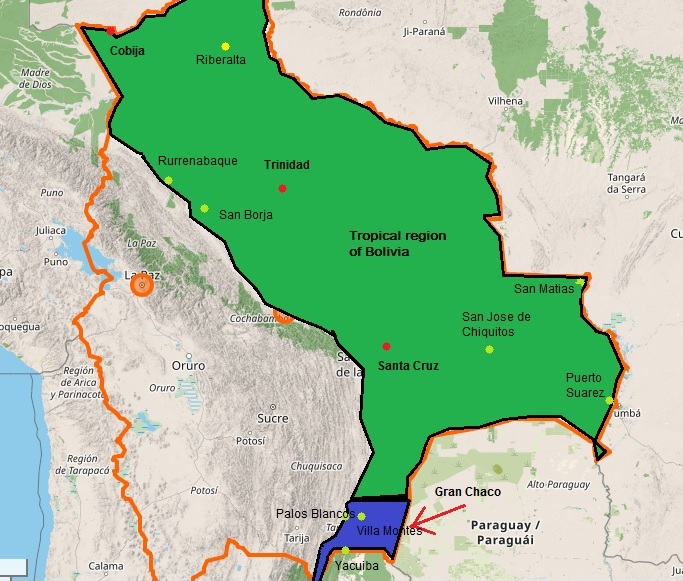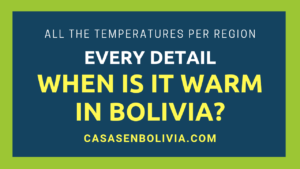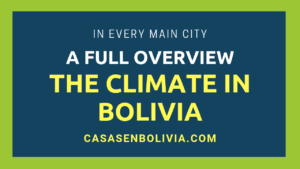Last Updated on February 15, 2025
Bolivia is primarily a tropical country, located very close to the Amazon rainforest. It’s a common misconception that Bolivia is only cold and mountainous (Altiplanic), as most of its population resides in warm areas where daytime temperatures typically reach 90°F (32°C) and don’t fall below 72°F (22°C) at night. In some locations, temperatures can soar to 110°F (43°C).
The hottest places in Bolivia are: 1) the Gran Chaco region, in the south of the country, including all its towns and rural areas, such as Villa Montes, with temperatures reaching 105°F (40°C), but sometimes up to 110°F (43°C); and 2) the tropical western region of the country, with temperatures around 100°F to 105°F (38°C to 40°C).
Here, we’ll discuss the seven hottest places in Bolivia, providing details about their maximum temperatures during the day and at night, and at which time of year, among other information. You’ll also learn why these high temperatures occur, the reasons for their intensity, and why they tend to happen at the end of the year. We are Bolivian real estate experts (see our Bolivian website).
Which is the Hottest Place in Bolivia?
In Bolivia, the hottest places are located on its tropical western side, where you can find tropical rainforests, tropical monsoons, and tropical savannas (the hottest place in the country), which resemble Amazonian landscapes but are slightly drier. This is why this part of Bolivia is so hot, and it comprises over 40% of Bolivian territory.
The Gran Chaco is the Hottest Place in Bolivia
The hottest place in Bolivia is currently located in the Gran Chaco (*in the far south of the country*), where towns and rural areas can sometimes reach temperatures up to 110°F (43°C). However, most of the time, temperatures hover around 105°F (40°C) on a sunny day, particularly from October to January. This region of Bolivia includes towns such as:
- Villa Montes
- Yacuiba
- Bermejo
- Palos Blancos
- Entre Rios
- And many other small towns
- No large cities
The Tropical Region of Bolivia is Only 2°F to 5°F Cooler
Other large areas can also become very hot, but they are not within the Gran Chaco. These areas are located in the western, northwestern, and northern parts of Bolivia, including places and cities like:
- Puerto Suarez
- San José de Chiquitos
- Robore
- San Matias
- The Chiquitania region
- Rurrenabaque
- San Borja
- Part of Madidi National Park
- Santa Cruz (the largest city in Bolivia)
- Trinidad
- Cobija
- Riberalta
In these tourist areas and towns, you’ll experience temperatures of 90°F (32°C) during the day, with peaks of 100°F to 105°F (38°C to 40°C). At night, temperatures won’t drop below 72°F (22°C).

Heat strokes are a real possibility in all these places, and you need to take all necessary precautions, particularly from September to April, when temperatures rise even higher.
Caution: Health Risk!
You must be very cautious *in all these regions*, as *you are at risk of* “Chagas disease,” a serious illness that damages your heart, can be fatal, and has no cure. It’s endemic in these regions (in the Gran Chaco, in Tarija, 48% of the population carries this parasite).
If you think that Santa Cruz is safer in this regard, that’s not the case. In Santa Cruz, 22% of the population has Chagas.
You should always look for living spaces *that are fully plastered, without any cracks, and also take other precautions*. Be extremely vigilant!
The 7 Hottest Places in Bolivia
1) Villa Montes Town
The town of Villa Montes, in the far south of Bolivia in the Tarija department, specifically within the Gran Chaco region, is undoubtedly one of the hottest urban areas in the country. It becomes extremely hot between September and April each year, the hottest season in the country, *but by far the hottest months are October through January*.
This town holds the unique distinction of *having recorded the highest official temperature ever in Bolivia*, which was 110.5°F (43.6°C) in February 2016. Furthermore, it typically experiences temperatures around 105°F (40°C) from October to January and above 95°F (35°C) in September, February, and April. The remaining months are cooler.
This town is within the Tarija department, in the very south of Bolivia, inside the Gran Chaco region, an arid tropical flat savanna also known as the stove of South America. *Villa Montes is not frequently visited by tourists and foreigners*, and beyond its high temperatures, it’s just a typical Bolivian town.
Remember to always be cautious about the possibility of heatstroke when you are staying in this town or nearby locations, as temperatures of 105°F (40°C) are common there at the end of the year. *Take all necessary precautions*.
2) The Bolivian Chaco
The Bolivian Chaco is part of the Gran Chaco region, which encompasses parts of Argentina, Paraguay, and Bolivia. This region is extremely hot, *particularly from October to January*, and also very arid, with virtually no rain during the middle of the year.
[Image: The Gran Chaco]
This land in the far south of Bolivia is characterized by having almost no rainfall from May to August, with a relatively hot climate. However, it becomes hotter with increased rainfall at the end of the year, *with temperatures reaching 105°F (40°C) almost every day*. In rural areas, this heat can be life-threatening, as there is limited access to healthcare and support.
Many towns that *become very warm* are located within the Gran Chaco on its Bolivian side, including:
- Villa Montes
- Yacuiba
- Bermejo
- Palos Blancos
- Entre Rios
- And many other small towns
This land is populated by agricultural workers and individuals who own land and work in these rural areas. They understand how to live there and how to cope with the extremely hot and, in many cases, very arid climate. *Tourists don’t typically visit the Gran Chaco region and its towns on the Bolivian side*, and there are no significant tourist attractions located there.
In this region, always be mindful of the high temperatures from September to April. You may experience the possibility of heatstroke, with temperatures exceeding 107°F (41°C), along with sudden droughts and desert-like landscapes.
3) Puerto Suarez Town
This is a small town located in the eastern part of the Santa Cruz department, on the border between Bolivia and Brazil. This region is tropical and very close to the climatic characteristics of the Amazon rainforest. Therefore, you would expect to experience significant heat year-round, but particularly during the country’s hot season, from September to April.
During the day, Puerto Suarez is almost always around 86°F to 95°F (30°C to 35°C) throughout the year, *but from October to January, it can reach temperatures of 106°F (41°C) on some days*. At night, temperatures can be around 73°F (23°C), and from October to January, they will remain around 79°F (26°C) and won’t drop below these warm levels.
However, *this town isn’t frequently visited by tourists*, as it doesn’t have much to offer. It’s primarily a commercial urban area serving as a border gateway between Brazil and Bolivia, reminiscent of the old days when the Tamengo Canal, which largely surrounds this town, was important and navigable.
Be especially cautious *at the end of the year* regarding potential heatstroke and similar issues in this town and nearby areas.
4) The Eastern Part of the Santa Cruz Department
In the far east of Bolivia, on the eastern side of the Santa Cruz department, there’s a flat tropical area *that experiences slightly warmer temperatures* than the rest of the western tropical areas within the country. This is because this area is closer to the Amazon rainforest and is located deeper within the equatorial region of the continent.
[Image: The eastern part of Bolivia]
Numerous towns and some tourist destinations with high temperatures year-round are located in this part of Bolivia:
- Puerto Suarez
- San José de Chiquitos
- Robore
- San Matias
- The Chiquitania region
As we just mentioned regarding Puerto Suarez, it’s common to see temperatures of around 106°F (41°C) on the hottest days in all these towns.
However, this part of Bolivia’s tropical region, encompassing Santa Cruz city and the surrounding areas, experiences slightly cooler temperatures, *specifically 2°F (1°C) lower*. These urban areas can reach temperatures of around 104°F (40°C) on the hottest days.
5) Rurrenabaque Town
This is a well-known tourist town in Bolivia, referred to as the gateway to Madidi National Park, but it’s also very hot. These high temperatures are due to the city’s location on wet and hot tropical land, close to the Amazon. *Therefore, you can imagine how hot this place can be throughout the year*.
Rurrenabaque and the surrounding towns and locations experience high temperatures throughout the year, averaging around 90°F (32°C), but some days, mostly from September to April, can reach up to 105°F (40°C). It’s also a very rainy place. Tropical rainstorms are common at the end of the year.
Rurrenabaque is a quite hot place due to its Amazonian climate. Although it’s not within the Amazonian region, it’s one of the warmest and rainiest places in the country. *When visiting this location, be cautious about the possibility of heatstroke*.
6) Central Part of Beni and La Paz Departments
This region of Bolivia, just above the center of the country, *is classified as a tropical rainforest (Af)*. Therefore, it exhibits an Amazonian climate, with over 2,000 mm of annual rainfall each year, and temperatures averaging around 90°F (32°C) year-round, sometimes reaching 105°F (40°C).
[Image: The central part of Bolivia]
Some well-known towns and tourist destinations are located in this part of the country:
- Rurrenabaque
- San Borja
- Part of Madidi National Park
The high temperatures there don’t subside at any time and are almost constant, with some drops of about 10°F (5°C) on some days in the middle of the year. Also, at night, it’s very unlikely to experience temperatures below 77°F (25°C) at any time. This hot weather doesn’t vary much and is persistent in this region.
7) Santa Cruz, Trinidad, and Cobija Cities
Large tropical cities in Bolivia can also become very hot, exhibiting average temperatures of 88°F (31°C) during the day, rarely dropping below 72°F (22°C) at night. In these cities, on some days, temperatures can reach 105°F (40°C) at the end of the year.
[Image: The largest tropical cities]
These important and well-known tropical urban areas include:
- Santa Cruz (*the largest city in Bolivia*, 1,500,000 population)
- Trinidad (131,000 population)
- Cobija (65,000 population)
- Riberalta (in the Pando department, 37,000 population)
Consider Santa Cruz, for example, Bolivia’s largest city. There, particularly from October to February, you’ll experience some days with temperatures around 100°F to 105°F (38°C to 40°C). *During these days, heatstroke is a serious concern*, so be cautious during these months when you’re in this city or other cities within Bolivia’s tropical region.
The other cities in the list above are also very hot, even hotter than Santa Cruz, and can reach 105°F (40°C) at the end of the year. However, temperatures don’t drop significantly for the rest of the year. This is because *all these cities are located in Bolivia’s tropical eastern region*, which occupies over 40% of the country’s territory.
Which is the Hottest Time of Year in Bolivia?
As you’ve seen throughout this article, the hottest time in Bolivia occurs at the end of the year, between September and April, *and it becomes even hotter between October and January*. This is because spring and summer occur during these months in the country. *These are the wetter and hotter seasons throughout Bolivian territory*.
We have a comprehensive guide on the hottest period of the year in the country, with all the figures regarding temperatures and locations involved, available here: The hottest time in Bolivia: All you need to know.
Conclusions:
In this guide to Bolivia’s hottest places, you’ve seen that two regions within the country contain all the hottest towns, tourist destinations, and rural areas you can encounter in Bolivia. These two regions are the Gran Chaco and the tropical eastern part of the country.
You now know that in the Gran Chaco, the highest temperature ever recorded in Bolivia occurred in the town of Villa Montes, reaching 110.5°F (43.6°C) in February 2016. Indeed, this town is the hottest place in Bolivia. However, you also know that all the towns in the Gran Chaco, such as Yacuiba, Bermejo, etc., will have similarly warm weather, with temperatures around 105°F (40°C) becoming common from May to August.
You’ve learned that there’s another region in the far east of Bolivia, close to the Brazilian rainforest and the Amazon, where towns like Puerto Suarez, San José de Chiquitos, Robore, San Matias, etc., experience very high temperatures year-round, averaging around 90°F (32°C), but reaching up to 100°F to 105°F (38°C to 40°C) on some days. This is due to the tropical rainforests present there.
Finally, you’ve realized that very large cities like Santa Cruz, Trinidad, and Cobija, among others, together housing over 2 million people, also experience very hot temperatures year-round, but particularly at the end of the year, with average temperatures of 88°F (31°C) and reaching up to 100°F to 105°F (38°C to 40°C) on sunny days. *Remember to always take all necessary precautions to avoid heatstroke in these locations, cities, and regions of Bolivia*.
We hope this information has been helpful. If you’d like to learn every detail about the climate in Bolivia, including more information on places with very warm climates, please visit our definitive guide here: How is the climate in Bolivia? A complete overview.
CasasenBolivia.com, information on living, working, investing, and traveling in Bolivia.








